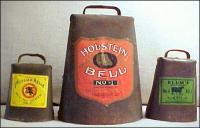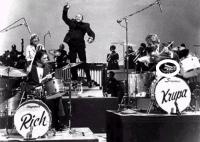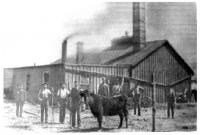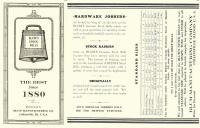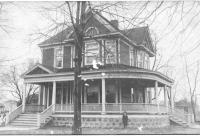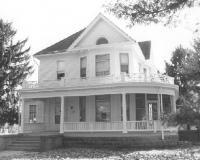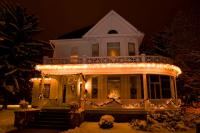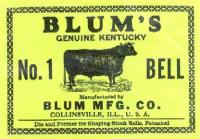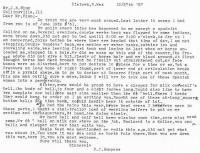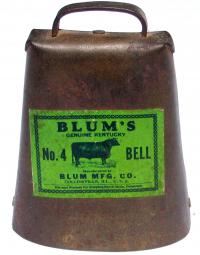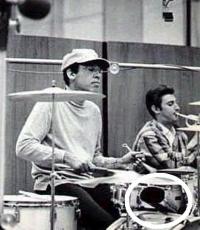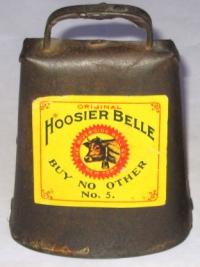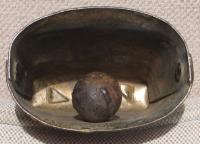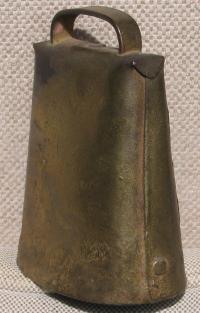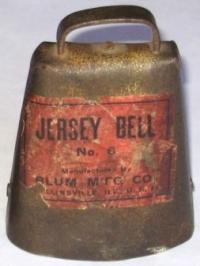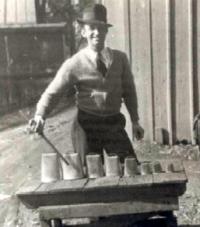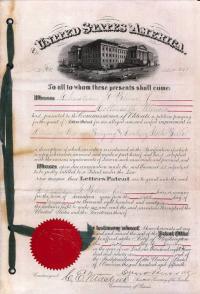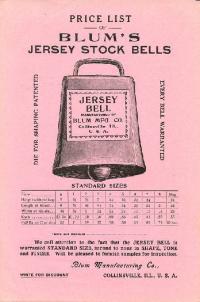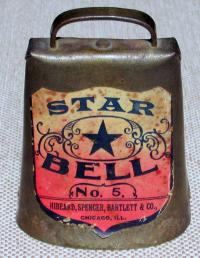

Blum Cowbells

Hello, and welcome! My family, the Blum family of Collinsville, Illinois, operated a small cowbell factory for three generations in that community. This site is intended to provide anyone with an interest in Blum cowbells with information about their history and manufacture. It is also intended to be a kind of memorial to my family which anyone can visit no matter where they are on the face of the earth. I plan to add more material, including more family photographs and photographs of different labels that were used, so please visit again.
--Virginia Blum Gaines
January 26, 2010
There are several ways to tell if an unlabeled bell is a Blum bell. One is to look at the shape of the bell. You'll notice in the picture that the bell does not have sharply creased edges that define the sides, but that it curves. This is because of the shape of the "former" mentioned on the red Holstein Bell label--"Die and Former for Shaping Patented." As you will see also, because of the curved sides, the bottom opening is oval and the bell flares out slightly around the opening. In the letter from the satisfied customer (see the link to "Customer Letter"), the farmer/rancher comments on how clearly his Blum bell could be heard across the lot. That is due to the shape of the bell, in addition to the brazing process.
Another feature to look for is the three-cornered fold at each side of the top of the bell. On a Blum bell, the corner was cut off with a definite point. I have seen other bells which had a blunt end to the fold. Also, the rivets that held the bell together down the sides were quite flat, which maintained the smooth and graceful appearance of the bell.
The loop through which the strap for the cow's neck would pass is flatter than loops on other cowbells I have seen pictured on eBay.
The 99%-of-the-time definitive way to determine if a bell is a Blum bell is to look up inside the bell. Please look at the bell interior pictured as you read this. Hold the bell sideways, as shown. You will see the small ring in the center top, from which the clapper was hung. (On the outside at the center top of the bell you will see a rivet that holds that small ring in place.)
You're looking for the ends of the large loop for the strap mentioned above, which were inserted through slits for that purpose and then bent inside the bell to keep them from slipping out again. The brazing process covered every possible chink around the large loop so that you can't see, from the outside or the inside, any evidence of the insertion of the ends of the loop.
HERE'S THE IMPORTANT PART -- on a Blum bell, the ends of the large loop were cut in points, not left blunt. One cut across the strip of metal that would form the large loop would do it. That cut was on a slant across the strip, not straight across. This is what you are looking for when you look at the ends of the large loop.
I have seen bells which were manufactured with the same process for attaching the large loop--probably this was a standard way of doing it--but only Blum bells had the metal strip cut this way. I have sometimes seen what appear to be blunt ends on a bell that otherwise looks like one of "ours", but only if the bell was in poor condition, very rusty, bent, etc., where the ends of that loop were already hopelessly misshapen or rusted away. In those cases, it really isn't possible to be completely sure the bell you have is a Blum bell.
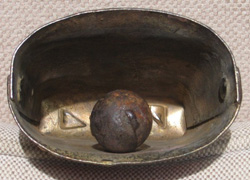
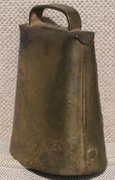
The family story about my great-grandfather, Christian Gottlob Blum (pronounced “Bloom”), was that he was born November 8, 1828, in Nagold, Germany, in the Black Forest. Records in Holy Cross Lutheran Church in Collinsville, Illinois, indicate that he was born in Wurttemberg, Germany. The date of his emigration to the United States is not known. Church records show that he was married to Maria Katharina Schoettle and they were the parents of seven children, one of whom was my grandfather, Johann Heinrich Christian Blum (who later went by the English version of his name, John Henry Blum), who was born in 1863 and was baptized in Holy Cross Lutheran. By that time they were probably living on a farm east of Collinsville.
My great-grandfather was a tinsmith, and eventually to follow this trade he moved his family into town and opened a hardware store. Tin roofs were of course everywhere then, and my great-grandfather invented a tool for seaming together the strips of roofing tin so that the roof would be more waterproof.
In 1844 a man named Joseph Moore had opened a blacksmith shop in Collinsville and had started making cowbells. My great-grandfather bought Mr. Moore’s business in 1876 and continued manufacturing cowbells. The business was then to continue for three generations. My father, John Henry Blum Jr., was the third generation to operate the bell factory. My grandfather died in 1935 and at that time my father assumed control of the business.
What is rather amazing about the factory is that the little building you see in the photograph with the cow (undoubtedly modeling one of the bells), and my grandfather in his Charlie Chaplin-like hat over on the left—that little building is the same building in which the bells were made from the beginning, and from which they were shipped all over the world until my father closed the business in 1956. At no time were more than 6 or 8 men employed there. According to an article in The Bell Tower, a publication for bell collectors, my family’s factory, with only this handful of employees, had a daily production rate of up to 1,000 bells, which made it one of the largest, if not THE largest, bell manufacturer in the country during the entire 75 years of its existence. (“America’s Cowbells” by Gary Spickler; The Bell Tower, Official Publication of the American Bell Association International, Inc. V. 59, No. 3, May-June 2001.)
The bells were not made of tin; nor were they made of iron, brass, or copper, although often antique dealers or sellers on eBay advertise them as such. They were made from sheet steel, cut with a flat pattern or “die” much as a garment is cut from cloth. You probably have seen the words “Die and former for shaping patented” on the Holstein bell labels. That refers to this part of the process. After being cut from the steel, the bell was curved around the “former”, which gave it its form or shape, and was then riveted along each side.
Take a look at the patent drawing: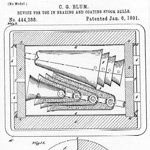
View a larger picture of the drawing in the picture gallery bellow
for the “Device for Use in Brazing and Coating Stock Bells.” To “braze” something is to coat it with molten brass. This was hot and sometimes dangerous work. I’m sure most of you have seen, either in person or in a film, molten metal being poured into containers in various kinds of factory work, so you know how hot that metal has to be! I can remember my father coming home for lunch on brazing days with bleeding and sometimes burned knuckles, because he took part in this work along with his employees. But it was this dangerous brazing process that gave the bells their distinctive tone, a clear and far-sounding tone that could be heard at a considerable distance. Please read the letter from a satisfied customer in Pietown, New Mexico, typed on the back of an advertising brochure for hearing aids! (If the letter is too small to read, try clicking on it to enlarge the image. Persevere on the letter! It's worth it!)
Many have asked whether a distinctive mark was stamped into the metal, as a way of identifying Blum bells. The answer is—no. They were and are identified only by the labels and by their distinctive and, to me, beautiful and graceful shape.
My father, John Henry Blum Jr., was always called “Bud.” He was born in Collinsville, Illinois, in 1902. My mother, Helen Downey, was born in East St. Louis, Illinois, in 1914. They married in 1936 and I was born in 1937. My father was a playful and witty man, with a great fondness for wordplay and stories. He told me wonderful stories about my teddy bear when I was little. He was a graduate of the University of Illinois. He was a great reader, and I have inherited his love of mystery — specifically Sherlock Holmes, but all types of mystery, including science fiction. My father was a big fan of H. G. Wells, Edgar Rice Burroughs (the creator of Tarzan), and H. Rider Haggard ("King Solomon's Mines"). He died in 1976.
My mother was a homemaker all her adult life and used her considerable creative talents to paint and re-decorate the interior of the house several times. Her home and the decoration of it were major interests throughout her life. She made most of my clothes when I was in high school and college (also U of I), and made many of her own clothes as well. She was also a great cook, and a devoted fan of the “old” Chicago Bulls — the Bulls from the days of Michael Jordan and Scottie Pippen. She loved anything to do with England. She died in 1997. I miss them both very much.
I am indebted for the information in this little history not only to my parents, of course, and to my own memory, but also to the rest of my family in Collinsville: Mrs. Fay Blumberg, widow of my cousin William Blumberg Jr., whose mother was Mrs. Lucile Blum Blumberg, my father's sister; Fay's son, William S. Blumberg and his wife Shelley. Other sources include Mrs. Margie Lou Greer, who has assembled much information from the records of Holy Cross Lutheran Church in Collinsville; the late Mrs. Lucille Stehman of Collinsville, who wrote a wonderful book, "Collinsville, Illinois: a pictorial history" (G. Bradley Publishing Co., St. Louis, Missouri, 1992); an article in the Missouri Historical Society Bulletin by Elizabeth Gillespie, published in 1949; and the article by Gary Spickler mentioned above, which was given to me by Bill and Lois Metzger of Collinsville, who also provided other articles.. So many people in Collinsville have shared memories with me in the last few years I can't mention them all; thanks to everyone who has taken such an interest over the years.
The following 2 paragraphs were written by Bill Blumberg (William S.), discussing 1) the use of the bells by musicians, and 2) the jobbers who sold Blum bells under their own labels.
"As the patent allowed for the brazing, the brazing allowed for the melodious tone of the bell, as you stated. That fact resulted in the bells being used as tympany on drum sets and in symphony orchestras; however, the most impressive use, to me, was the contracts which Uncle Bud had with major drum set manufacturers, most notably Ludwig and I believe, Slingerland. During The Big Band Era, Blum bells appeared on the bass drums of such notable drummers as Gene Krupa and Buddy Rich, two of the greatest drummers of all-time. For proof, I cite The Benny Goodman Story (1955), starring Steve Allen as Benny Goodman, in which Gene Krupa plays a wonderful drum solo (I believe it was Swing, Swing, Swing) at Carnegie Hall (Goodman's band was the first swing band to play the prestigious symphony venue, I believe). During that solo, a close-up of Krupa's drum set shows the distinctive oval Blum Bell (a "0" or a "1") on the bass drum. By the way, no mark was necessary. The shape as shown in the patent drawing was the trademark!
"There were lots of bells manufactured for hardware jobbers. These were companies which sold products manufactured by various companies, but marketed under the jobber's name. Many had catalogs which they distributed, not unlike what Sears did. The advantage to them was that they were a 'one-stop' shop for farmers and once the farmer did business with them, he might keep coming back, so they specialized in carrying a diversified number of items with farming or hardware as the central theme. The result was that Blum bells were actually carrying lots of names for other people. Uncle Bud told me that the bell was exclusively made with the oval shape, the rivet and the tricornered fold. Uncle Bud also told me that in 1876 there were only three cowbell manufacturers in the world. One in India, one in Switzerland and one in Collinsville. By the time he closed the shop, there were more, particularly one in New Jersey (which made a rectangular bell). So, while I can't claim certainty, until I could find proof to the contrary, I would assume any bell shaped like ours, IS a Blum bell which was made for someone else to market under their name."
Here are two photographs Bill sent me, which show Buddy Rich alone in one of them, and the two bands of Rich and Gene Krupa in the other.
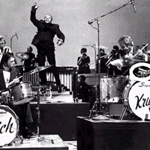
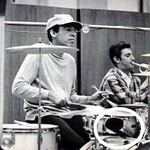
In the photo of Buddy Rich alone, the bell is in the white oval in the lower right corner. You're looking at the open bottom of the bell (a large dark oval shape) and the side seam. You can see the rivets. The bells were not rung but struck with the drumsticks, so the clapper was not present.
In the photo of the two bands, the bell used by Krupa is in the white oval just above the large drum which says “Krupa” on it. You can see the side of the bell facing toward you, looking very shiny, with the dark oval of the open mouth. Krupa is sitting at his drum set and it looks like he would have struck the bell from his left. As you have read already, one of the companies providing musicians' supplies was the Slingerland Drum Co., to which my father regularly shipped bells.
The Star Bell label is a good example of a Blum bell sold by a jobber, and in fact the yellow Hoosier Belle label is another. The "Star" label was used by a large hardware firm in Chicago--Hibbard, Spencer, Bartlett & Co.
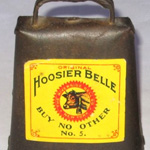
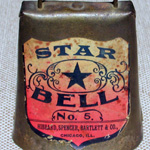
Sargent bells, however, come from another manufacturer, Sargent Company in New Haven, Connecticut. They were in business during the late 19th or early 20th century. They are shaped differently than Blum bells, with wider shoulders giving them a "tapered" appearance from top to bottom, and wider sides giving a rectangular rather than oval opening. (Sargent may, in fact, be the manufacturer thought to be in New Jersey.) Please search for "Sargent cowbell" using whatever search engine you like best; you should find a number of places where dealers are selling them, with pictures.
If anyone has more information on the vendors mentioned above, please let me know! And if anyone has information on other vendors that sold Blum bells under their own labels, also please contact me! virginiabgaines@gmail.com Blum Bell Vendors Info
Bill Blumberg Jr. wrote this poem about the bell factory and the bells:
The Blum Holstein Cowbell
Yes, I was there in ‘Fifty-five, though just a little boy.
There was no bus’ness left to thrive; no methods to employ.
The furnace cold, equipment sold, the foundry black with soot;
The pot of gold grown empty, old; customers all afoot.
The art was lost and at what cost would toll those works’ death knells,
And there were tossed Holstein embossed, clear toned, brass plated bells;
Teenagers bopped, the charts were topped by that new rock ‘n roll.
Real music dropped, and sales soon stopped: that is what took its toll.
By Slingerland or Ludwig manned, the drum rolls ceased their boom.
They were at hand in each Big Band, the cowbell made by Blum.
In new phasing, cows were grazing, confined in large feed lots;
Reappraising, less bells brazing to fill crucible pots
With all that brass they would amass to make these bells unique;
And thus would pass the chance, en masse, the markets they might seek.
The tri-fold top, riveted stop, no patent could replace.
Collector’s shop; no antiques top that distinct oval base;
So, these bells will not remain still, as long as there presents
The need to fill the sports fan’s thrill at all sporting events.
There’s still around that unique sound which we all know so well.
Happily found, they still abound: The Blum Holstein Cowbell!
© Copyright 2004, William S. Blumberg, PoemorialsT.M The Closing of the Blum Manufacturing Co. All Rights Reserved.



